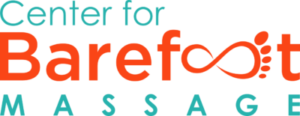“Give it weight, then wait” to impact the fascia (but really, the nervous system) is a pretty heavy theory that we’ve found to be important to our FasciAshi technique. Addressing the deep fascial bands, navigating the contours of muscle and bone, and applying a great amount of pressure directly to specific tissues creates a form of myofascial release that your hands only WISH they could achieve with such consistency and accuracy. The broad pressure from a Barefoot Massage is a no brainer for deep bodywork. Moving slower, OR NOT AT ALL, helps you get to that “deeper than deep tissue” feeling so many clients are looking for.
(Did you read Part 1 of this post? Check it out here.)
Since we taught our first class, we’ve been asked “well, if FasciAshi is myofascial release and trigger point work, why is there so much lotion and why are you still moving so much in the stroke?”
Ok, fair enough! Before a massage therapist can stop dead in their tracks and hold pressure for long periods of time, we first need to teach them how to palpate with their feet, discover new angles of pressure while using these new limbs, and develop control and momentum. Annnnnd to know why each stroke matters so they’ll know how to sequence it all together later.
The moving strokes from FasciAshi Fundamentals teach LMT’s to access and maintain levels of depth within the clients tissue with more consistency while they are moving their own bodies in new pathways, and figuring out how to use the leverage of the bars, straps and table to their advantage.
Once a therapist understands how to manipulate and nourish the superficial layers of fascia and muscles thru variations of strokes that we teach, they’ll develop the tactile sensations, intuition and control, THEN they will be able to stop, drop some weight, and engage the deep fascial layers more effectively. We dive down into that practice in our Intermediate FasciAshi class. The neuromuscular remapping that happens when sustained compression, especially from the broad surface of a trained foot, is applied to the bodies of our clients, has shown to increase interoception, AKA internal body awareness.
Have you ever had clients or acquaintances who are so disassociated with the pain in their bodies that they don’t know where exactly it is? Or how to visualize or even verbalize it?
Humans in today’s culture are so over stimulated that we can’t even process what we are feeling. Their pain may be unbearable, nagging, and general, but not easy to describe. It might not even be pain: It’s just life. <<I can’t even sometimes, you know?!>>
A big benefit of barefoot massage is the large footprint it leaves on our clients… both figuratively and literally. The deep, broad pressure is stimulating so many receptors in the body underfoot, that it commonly seems to take a moment longer for the nervous system to understand and process what you are doing to it! Pain is all created in the brain anyways, so the more healthy, safe tactile information you can send neuromuscularly to their head, the better. This is one of the reasons why s-l-o-w ashiatsu strokes are imperative, and why sustained compression is even better.
Have you noticed in yourself and those who you massage that they are more “massage drunk” after their first deep massage session (or their first one in a l-o-n-g time) compared to others who receive it regularly?
That’s not toxins, it never is or was. You are watching their whole body go through a moment of change that is reabsorbing fluids into thirsty tissues like a sponge, while recalibrating proprioceptive sensations… and maybe even retraining a pain response!
Have you ever heard a yoga instructor say that “Savasana is the most important, and hardest, yoga pose” … when all that’s seemingly happening is a nice little blissed out nap at the end of yoga class?
They are right. It’s SO MUCH MORE than nap time. Your mind and body…. or nervous and muscular systems… are now talking to each other outside of the fight or flight mode. They are getting out of their heads. It’s like a reboot or reset button has been pushed. The same thing is happening during a massage.
FasciAshi encourages our students feet to think for themselves.
Here’s a thought: instead of constantly effleuraging, gliding and dragging back lightly with your feet, just stop. Stop moving. Stop overstimulating with more distraction. Find the point of most resistance, find the right angle, the perfect part of your foot for the job, visualize the topography of the tissue and find the deepest layer of fascia, and bring both you and your clients focus completely on that spot. Give it some weight, and then wait. Both of you visualize and verbalize what you are feeling. Hold the pressure until it dissipates. Until you both forget why you are there. Then slide and bodysurf until you find another spot. Use this as an educational tool to teach your client a real anatomy lesson.
You’ve probably wanted to do this with your feet anyways… SO DO IT!
It’ll take some breathing on both your parts, it’ll take great body mechanics, control and patience on your end, but you’ll start to see remarkable changes.
Give them your heel, then wait for them to heal themselves…
…Start a stroke with no expectations, and see where it takes you both…
…Let them learn about their body as much as you are.
We’ll teach you all this in our FasciAshi classes.
It’s the barefoot massage you’ve been WEIGHTING for.
(Ok, that pun might not work.)

Please note: we reserve the right to delete comments that are offensive or off-topic.